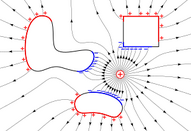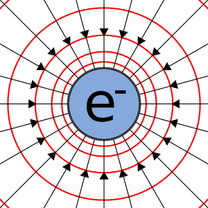Point charge potential and at the phase interface
Electric potential is a physical quantity characterizing the energy conditions of an electrically charged particle located in an electric field. It is usually denoted by φ and the unit is volt [ V ]. The symbol U is usually used for the difference of two potentials called the electric voltage. It should be noted that in medical applications, this physical and technical division is not strictly distinguished, so that, for example, it is commonly referred to as action potential , although it is actually "action voltage" . However, since there is no risk of confusion or error, it would be a mistake to try to forcibly introduce physically correct nomenclature in physiology.
The properties of a particular electric field can be fully described by the magnitude of the electric potential φ or the electric field intensity E. These values are quite simply related to each other and can be recalculated, each is more suitable for different purposes. The shape of the electric field can be complex in general, but in the case of a point charge its shape is very simple. Since the electric field is influenced not only by the distribution of charges in the environment, but also by the dielectric properties of the environment, the shape of the electric field at the interface of two environments with different permittivity is deformed .

Quantities describing the electric field[edit | edit source]
Electric field strength[edit | edit source]
The intensity of the electric field E is a vector physical quantity that is directly related to how much force the field exerts on the embedded point charge. Its unit is V·m-1 (Volt per meter), sometimes N·C-1 (Newton per Coulomb) is also used. Its physical meaning is the force that would act on a unit positive test charge placed in an electric field. The force acting on the real charge Q can then be calculated very easily:
Electric potential[edit | edit source]
The electric potential φ is a scalar physical quantity that has a direct relationship to the energy ratios in the electric field. Its unit is Volt ( V ). The idea behind introducing an electric potential is to intentionally move a "trial" charge q in an electric field. At every point in the electric field, a force acts on a unit charge. If the charge moves perpendicular to this force, no work is done - we say the charge moves along an isopotential surface. More interesting is the situation when the charge moves at least partially in the direction or against the direction of the force induced by the electric field. Then the field performs the work or external forces do work that can be measured or calculated and is usually denoted by Δ W. The magnitude of this work depends only on the shape of the electric field and the size of the charge, so the potential can be introduced as the magnitude of this work relative to the magnitude of the charge:
The symbol Δ means change or difference. When thinking about the consequence of this definition, one important problem becomes apparent - namely, we can measure or calculate the difference between two potentials (that is, electric voltage), but we cannot determine its absolute value. Therefore, the zero value of the potential is usually chosen by agreement, for example, at infinity or on some specific significant body, for example, on a body conductively connected to the ground.
Relationship between potential and intensity[edit | edit source]
Electric field intensity and electric potential are closely related, but the mathematical formulation of this relationship goes beyond ordinary high school mathematics. The presentation is only illustrative for those who have a closer relationship with the natural sciences.
The intensity is calculated from the potential using the gradient operator (the third expression is the definition of the gradient):
The gradient operator of a scalar function of multiple variables has the meaning of the magnitude and direction of the largest change. This means that the electric field intensity vector is equal in magnitude and direction to the opposite vector to the vector of the greatest change in electric potential .
An interesting and often used consequence of the properties of the gradient is that the lines of force crossing an isopotential surface are always perpendicular to it.
Even the calculation of the potential from the intensity is formally easy, it is written using the integral along the (oriented) curve C connecting the points between which we are interested in the potential difference:
To understand, it is necessary to remember that E is actually a force acting on a unit charge, so the product of the absolute values of E·s has the meaning of the work that would be done by the displacement of the unit charge. The curve integral can be understood as taking the curve connecting the points of interest and dividing it into sections so small that they can be considered line segments, and the electric field strength along that line segment can be considered constant. At each such section, the work that would be done by a unit charge through the passage is calculated:
The index i denotes a sub-section, E the magnitude of the electric field intensity at the location of the given sub-section, l the length of the sub-section and α the angle that the respective sub-section makes with the vector E . The total integral is then the sum of the values of the individual parts.
Electric potential around a point charge[edit | edit source]
It is not difficult to guess that in the vicinity of a point charge the electric field will be spherically symmetric, so that the field lines will emanate radially from the center of the charge and the isopotentials will be concentric spherical surfaces. If the value of the zero potential is set to infinity, then a simple relationship applies to the magnitude of the potential at a point located at a distance r from the central charge Q :
So the electric potential is inversely proportional to the first power of the distance from the charge. A point charge is only a physical abstraction, it does not exist in reality and cannot exist, because in its vicinity the potential would reach arbitrarily high values. However, it turns out that the point charge is a sufficiently faithful approximation for charged spherical bodies with a uniformly distributed charge on the surface or sufficiently small bodies. Thus, we can consider as point charges (depending on the nature of the problem being solved) for example electrons generated in a photomultiplier , some inorganic ions in solutions or, for example, ionized functional groups of biologically significant macromolecules.
Links[edit | edit source]
Sources[edit | edit source]
- KUBATOVA, Senta. Biofot [online]. [cit. 2011-01-31]. <https://uloz.to/!CM6zAi6z/biofot-doc>.
- SEDLÁK, Bedřich – ŠTOLL, Ivan. Elektřina a magnetismus. 1. edition. Praha : Academia a Karolinum, 1993. ISBN 80-200-0172-7.
- SVOBODA, Emanuel. Přehled středoškolské fyziky. 3. edition. Praha : Pometheus, 1996. ISBN 80-7196-116-7.
External Links[edit | edit source]
- Czech translation of the Electricity and Magnetism course from MIT: [1]







